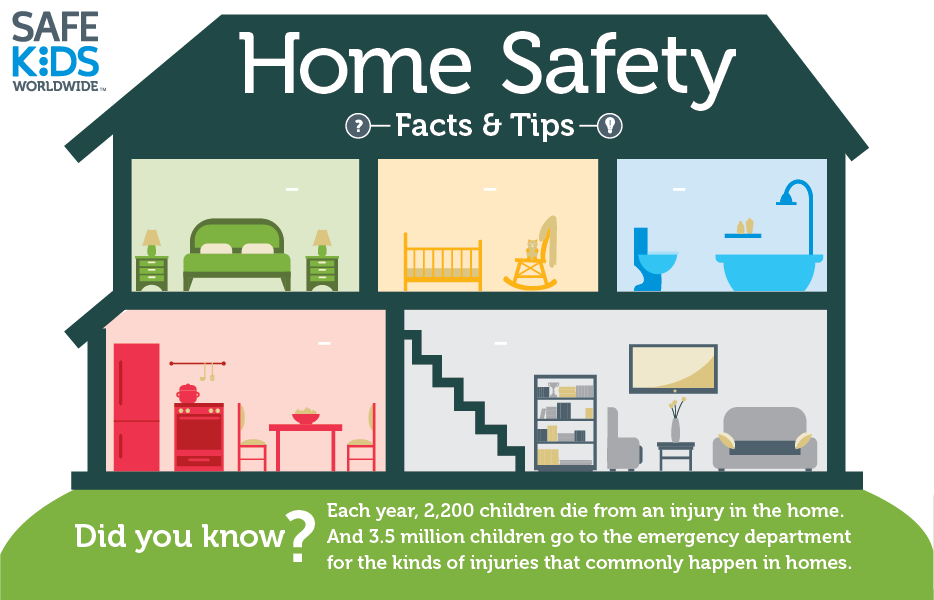More Home Safety Tips
Thursday, February 1, 2018

You can get hurt in every room in your home, believe it or not. We often take our safety for granted and don’t realize how dangerous our homes can be to us if we are not fully alert or if we are careless due to illness or fatigue. Here are a few more things to think about and save you and your family injury or even tragedy.
Clutter can be Dangerous
Yes, that sounds ridiculous but it’s truer than you might know. Families with children are constantly fighting clutter and chaos so it’s important to know which clutter is injurious.
Every child and many adults love building blocks but anyone who has ever stepped on a Lego can attest that they can be quite painful. Keep blocks out of family paths such as the path from the living room to the kitchen, the playroom or bedrooms to the living room, etc. The small blocks are not the only dangerous ones, though. Those large building blocks for toddlers are big enough to trip over and should be confined as much as possible to the child’s building site.
Magazines cause many injuries, believe it or not. If you have even slipped on a glossy magazine that was discarded beside the couch, you’ll know how easy it is to fall because of one. Keeping a magazine rack beside a chair or a couch and using it habitually will prevent such accidents and save a lot of pain. The same should be done with books.
You might really like the realistic sculpture of a sleeping otter that you’ve placed next to the couch or in the entryway but a visitor to your home may not see it. Tripping over something like that can break bones at worst and be embarrassing at best. Sculptures that are low to the ground should be placed on stands or tables so that you can enjoy them safely. Look around and see what other knick knacks or artwork might present a danger to family or guests.
Stay Safe Where You Sleep
The bedroom is one of the most important rooms in your life since you spend eight hours or more a day there. It should be comfortable but it should also be safe. The first thing you should do to make your bedroom safe is to install an inexpensive, automatic LED nightlight.
Keep sharp objects and protective devices in the drawer of a nightstand, not on top. When a person is half asleep they sometimes can’t distinguish between their inhaler and the small canister of pepper spray on their nightstand. Likewise, reaching for a glass of water can result in a big spill rather than relief. If you need to keep water by your bed it should be in a water bottle with a lid instead of a glass.
It’s not a great idea to have area rugs in a bedroom, especially if you get up at night. Your senses are not alert and you could forget that a rug is in front of you; if you don’t lift your feet high enough you’ll trip over the rug and could be badly injured.
Never keep a weapon beside your bed. You could hurt yourself or a loved one if you are suddenly awakened. The safest security precaution to have on your nightstand is a landline or a cell phone that you can use to call the police while you retrieve the pepper spray or other protective object from a nearby closet. The simple act of taking 3-4 steps will awaken you enough to know that it’s a family member silhouetted in the doorway, not an intruder. The placement of your family’s defense could save you from a lifetime of sorrow.
If you wake up at night with aches and pains be sure that you are taking the medicine you intended. Turn on the bathroom light and look at the label carefully. Better still, use your medicine cabinet for routine personal care items and store medications of all types on a high shelf elsewhere. You might have to wake up more to deal with your headache but you can be sure of taking the proper medicine while keeping it out of the hands of young children and pets.
Young children’s bedroom should definitely have a nightlight and the floor should be cleared of debris before they retire each night. Make sure the hallway is clear, too. If you have stairs and young children you should install a safety gate at the head of the stairs (and preferably at the bottom, too). A simple safety gate can prevent middle of the night falls and serious injuries or death. Chests of drawers, armoires, and other heavy furniture should be anchored to the wall to prevent them falling on a child.
Common Sense Goes a Long Way
Every few months it’s a good idea to walk through you home and pretend that every object is dangerous. Think about all the way that you or someone else could hurt yourself on the couch, with the toys, with the window treatments, and everything else. You’ll be surprised what you’ll think of but if you take steps to correct such scenarios, you will prevent nasty surprises later.







Sorry, comments for this entry are closed at this time.